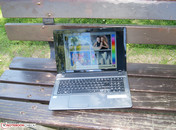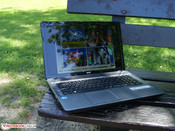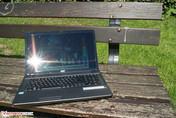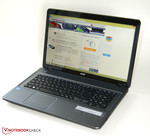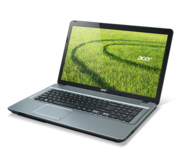Acer Aspire E1-771-33114G50Mnii Notebook Review

For the original German review, see here.
Priced at 500 Euro (~$680) and sporting a 17-inch screen, the Acer Aspire E1-771 is a business notebook which competes in the lowest possible price bracket. We are pretty familiar with the E1-series, since the 15-inch and 17-inch models usually fare pretty well in our reviews. Notebooks in this segment of the market are designed to handle various office tasks and web-surfing duties. Small differences in price sometimes mean significant changes in quality and performance. What other applications the Acer E1-771 was designed for and what the notebook can't handle is the subject of our review.
We'd like to point out what difference a few dollars more can make: for about 100 Euro (~$135) more, models in Acer's E1-772-series come equipped with twice the amount of RAM, a better i5 processor, Full-HD display, and dedicated Nvidia GT 820M. For around 630 Euro (~$850), Asus sells their Pro P750LB with a dedicated Nvidia GT 740M GPU and a matte screen. For around the same price as the Acer E1-77, Toshiba offers the Satellite C70D with AMD components.
Case & Connectivity
The E1-771 is made entirely from plastic, is free of any optical gimmicks, and looks quite unobtrusive. The matte surfaces also offer some protection against fingerprints. The notebook feels OK to the touch, but some concessions obviously had to be made as well as far as the transition areas of the base unit, the keyboard surface area, the display lid and the display panel itself are concerned. We also couldn't fail to notice the very smooth surface of the gray display lid, which just doesn't look very upscale due to the rounded edges. To us, the Aspire E1-771 feels a tad unwieldy.
The location of the ports towards the front of the notebook ensures that they are within easy reach. The layout suits righthanders, since the right edge is only home to one USB 2.0 port as well as the DVD optical drive. All important connections, like USB 3.0 or HDMI are found on the left side. If a mouse is used on the left side, cables can get into the way of operation. Less than ideal is the placement of the SD card reader on the front edge, even though the E1-71 would offer plenty of room for a different location.
Input Devices
Keyboard
The black chiclet keyboard comes with a separate numeric keypad. The keys are precise but a little stiff; the sound emitted not overly noisy. We don't particularly like the the combination keys (caps lock with less than / greater than keys and Enter key with the number sign). The placement of those keys right next to each other makes accidental mistypes a lot more likely when a finger slips. Unfortunately, Acer doesn't incorporate any special function keys despite the ample space available. Considering the price of 500 Euro (~$680), the keyboard is pretty decent though - we've encountered worse in higher-priced notebooks.
Touchpad
We appreciate the large touchpad with its slightly rough surface. A single mouse button with rounded corners sits at the lower edge. Multitouch of up to two fingers is supported, which allows zooming and scrolling without issues. Despite the low price, working with the touchpad is a satisfying experience.
Display
The 17.3-inch display with a 16:9 aspect ratio features 1600 x 900 pixels and thus doesn't quite reach Full-HD resolution. As we mentioned in our introduction, Acer also sells the E1–772 with a matte Full-HD display. Users who don't need a high-resolution display should be fairly happy with the glossy panel our review notebook comes with: the average brightness of 242 cd/m² is slightly above average for the business category and both the contrast of 534:1 as well as the black value are decent for an affordable notebook. Except for the models in the E1-772 series, the display of the E1-771 outperforms the ones used for the Asus Pro P750LB and the Toshiba Satellite C70D.
| |||||||||||||||||||||||||
Brightness Distribution: 84 %
Center on Battery: 199 cd/m²
Contrast: 534:1 (Black: 0.464 cd/m²)
ΔE Color 10.43 | 0.5-29.43 Ø5
ΔE Greyscale 11.64 | 0.57-98 Ø5.3
56.5% AdobeRGB 1998 (Argyll 2.2.0 3D)
80.6% sRGB (Argyll 2.2.0 3D)
54.6% Display P3 (Argyll 2.2.0 3D)
Gamma: 2.23
The Calman software reveals some issues with the color reproduction. The deltaE deviations are not that great with values above 10. The noticeable bluish cast fortunately disappears after a calibration. The viewing angles are also restricted and the display is prone to changes in brightness and color accuracy at various angles. This is especially bothersome when watching movies or Youtube videos with friends.
The reflective display makes the notebook unusable in direct sunlight. Outdoor use is possible in the shade, although taking the almost 3 kg heavy behemoth with its rather short battery life outside might not make that much sense in the first place.
Performance
Integrated into the Intel Core i3-3110M is the Intel HD 4000 GPU, which can handle some games provided the settings are on low. The overall TDP is 35 watts; the power adapter supplies 65 watts and is adequately sized to handle the load. The 4 GB RAM module takes up one of the available slots so another module can be added. This would increase the performance of the Intel HD graphics card, since the RAM would now run in dual-channel mode. The hard drive of 500 GB with a rotational speed of 5400 RPM is also fairly standard for this class, although we'd like to see an SSD at least as an option. More demanding users might want to take a look at the E1-772G-series, which costs about 100 Euro (~$135) more, but offers an Intel Core i5-CPU, 8 GB of RAM, and a dedicated Nvidia GT 820M GPU.
Processor
The Intel Core i3-3110M CPU Acer equips the E1-771 with is an entry-level processor part of the older Ivy Bridge and not the newer Haswell architecture. The dual-core (four threads) CPU is clocked at 2.4 GHz and can handle office-type tasks and online duties quite well. Unlike the CPUs in the i5 and i7 series, the i3-3110M lacks a Turbo Mode. The E1-772G features a Haswell CPU with a slightly higher clock speed and a Turbo and scored 40 % higher in the Cinebench R11.5 benchmark. Compared to its competitors, the E1-771 with the i3 does well, however. The Toshiba with the AMD A4-5000 CPU posted single-core scores that trail the i3 CPU by 60 %; the multi-core results are also worse with 38 % less performance.
System Performance
We ran into some issues with the Acer E1-771, since the supplied drivers either didn't allow some programs to run at all or crashed them prematurely, which prevented a smooth workflow. The PCMark 7 benchmark was not impacted by this behavior, so the results are much better than those of the competitors, which already fell behind during the CPU tests. Only the more powerful Acer E1-772G outperforms the other notebooks by a fair margin.
| PCMark 7 Score | 2344 points | |
Help | ||
| PCMark 7 | |
| Acer Aspire E1-771-33114G50Mnii | |
| Score |
|
| Acer Aspire E1-772G 54208G1TMnsk | |
| Score |
|
| Toshiba Satellite C70D-A-10L | |
| Score |
|
| Asus ASUSPRO P750LB-T2057G | |
| Score |
|
Mass Storage
Let's take a look at the 500 GB hard drive manufactured by Western Digital. According to HD Tune and CrystalDiskMark, the 5400 RPM drive has an average data transfer rate of 80.5 MB/s and 94.83 MB/s, respectively. These results are below average, and all other notebooks in our comparison scored better. The platter-based drive particularly has issues with 4K performance and trails the others with 0.433 MB/s reads and 1.262 MB/s writes.
GPU Performance
The integrated Intel HD Graphics 4000 is responsible for graphics duties. Unlike the CPU, the GPU has a Turbo which can increase the base clock rate of 650 MHz to 1000 MHz. Nonetheless, users with gaming ambitions should definitely look at notebooks with dedicated graphics cards like the already mentioned Acer E1-772G. Our review notebook scored 540 points running 3DMark11, which is 1200 points less than the AsusPro P750LB.
| 3DMark 06 Standard Score | 3985 points | |
| 3DMark 11 Performance | 540 points | |
| 3DMark Ice Storm Standard Score | 33303 points | |
| 3DMark Cloud Gate Standard Score | 3063 points | |
Help | ||
Gaming Performance
The game-specific benchmark confirm the results of the 3D benchmarks. The Intel HD Graphics 4000 is not really suitable for most games, although some classic titles will work as long as the user doesn't mind using the lowest possible settings. Anno 2070 from 2011 runs at 31 fps, which is in playable territory, but only just. Other notebooks in the same category are capable of higher frame rates.
| low | med. | high | ultra | |
| Anno 2070 (2011) | 30.9 | 15.9 | 10.8 |
| Acer Aspire E1-771-33114G50Mnii HD Graphics 4000, 3110M, Western Digital Scorpio Blue WD5000LPVX | Acer Aspire E1-772G 54208G1TMnsk GeForce 820M, 4200M, WDC Scorpio Blue WD10JPVX-22JC3T0 | Asus ASUSPRO P750LB-T2057G GeForce GT 740M, 4010U, Toshiba MQ01ABF050 | |
|---|---|---|---|
| Anno 2070 | 149% | 180% | |
| 1024x768 Low Preset | 30.9 | 91.6 196% | |
| 1366x768 Medium Preset AA:on | 15.9 | 41.6 162% | 45.4 186% |
| 1366x768 High Preset AA:on AF:2x | 10.8 | 25.4 135% | 27.9 158% |
Emissions
System Noise
Since the E-771 doesn't have high-performance hardware, the noise levels are well controlled. Even under full load, the notebook only reaches 34.7 dB(A); competitors with dedicated GPUs are closer to 38 dB(A). Slightly annoying is the fact that the fan is always on - even during idle. Since the noise floor is only at 31.2 dB(A) this isn't a major issue, however.
Noise Level
| Idle |
| 31.2 / 31.2 / 32.3 dB(A) |
| DVD |
| 35.7 / dB(A) |
| Load |
| 32.5 / 34.7 dB(A) |
 | ||
30 dB silent 40 dB(A) audible 50 dB(A) loud |
||
min: | ||
Temperature
Thanks to the low power consumption of the CPU and the lack of a dedicated graphics card, the Acer E1-771 doesn't get very hot. Only rarely did we encounter temperatures above 30 degrees C during load. As expected for a 17.3-inch notebook with Intel Core i3-3110M CPU, throttling is not an issue. We also had no problem using the E1-771 on the lap. The fairly small power adapter does heat up under load conditions (we measured up to 50.4 degrees C), so adequate cooling is necessary and the user needs to ensure proper airflow.
(+) The maximum temperature on the upper side is 33.3 °C / 92 F, compared to the average of 34.2 °C / 94 F, ranging from 21.2 to 62.5 °C for the class Office.
(+) The bottom heats up to a maximum of 34 °C / 93 F, compared to the average of 36.7 °C / 98 F
(+) In idle usage, the average temperature for the upper side is 27 °C / 81 F, compared to the device average of 29.5 °C / 85 F.
(+) The palmrests and touchpad are reaching skin temperature as a maximum (32 °C / 89.6 F) and are therefore not hot.
(-) The average temperature of the palmrest area of similar devices was 27.7 °C / 81.9 F (-4.3 °C / -7.7 F).
Speakers
A large notebook should have a good sound system - but unfortunately, the Acer proves us wrong. Bass is completely lacking and the overall sound is compressed throughout all frequency ranges. Adjustment of the frequencies do not help much. For YouTube videos the sound quality should be sufficient, but for other applications we recommend connecting external speakers.
Energy Management
Power Consumption
During idle, the Acer consumes an average of 8.5 watts, which is comparatively little. Of course, systems with ULV processors like the AsusPro P750LB need less. Under load, the E1-771 requires up to 40.5 watts, which is on the same level as the AsusPro P750LB with a dedicated graphics card. The Toshiba Satellite C70D with an average load consumption of 22.3 watts is the power miser of the group.
| Off / Standby | |
| Idle | |
| Load |
|
Battery Life
The 44 Wh battery doesn't offer a lot of capacity and the Acer quit after exactly 3 hours during our WLAN test (brightness set to 150 cd/m²; a script changes webpages every 40 seconds), which is one hour shorter than the competitors. Since the battery is swappable, power users might consider the purchase of a second battery if they intent to use the notebook away from outlets a lot. The AsusPro P750LB with the ULV processor posted the best battery life with 4 hours and 35 minutes.
Verdict
What exactly can we expect from a notebook retailing for 500 Euro (~$680)? Let's summarize the most important points: the E1-771 is equipped with a standard and rather average TN display panel but features very good input devices. The touchpad is precise and the keyboard has very good feedback. Unfortunately, the physical ports are located up front, but at least all important physical connections are included. The Intel Core i3 processor works well for office-type applications and can handle some older games as well. Even when pushed to the limit, the Acer E1-771 stays quite cool. Negative aspects are the fairly average battery life, the sturdiness of the plastic components, the quality of the speakers, and the highly reflective display. Potential buyers who have a little extra money to spend should consider the aforementioned Acer E1-772G. The AMD-equipped Toshiba Satellite C70D costs as much as our review notebook but doesn't do anything better. The E-771 can be used as a business notebook; upgrading the RAM or swapping out the hard drive for an SSD is also possible without any problems.


 Deutsch
Deutsch English
English Español
Español Français
Français Italiano
Italiano Nederlands
Nederlands Polski
Polski Português
Português Русский
Русский Türkçe
Türkçe Svenska
Svenska Chinese
Chinese Magyar
Magyar





